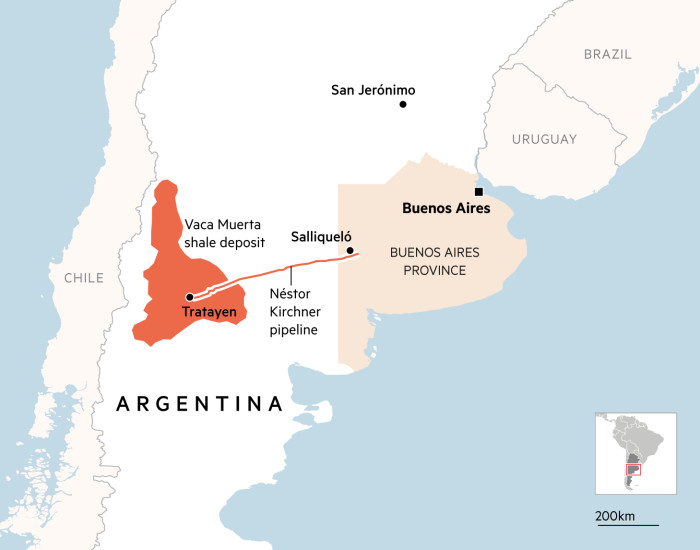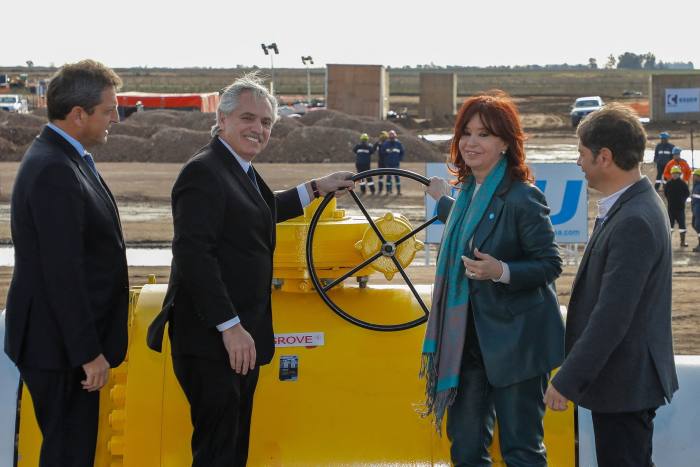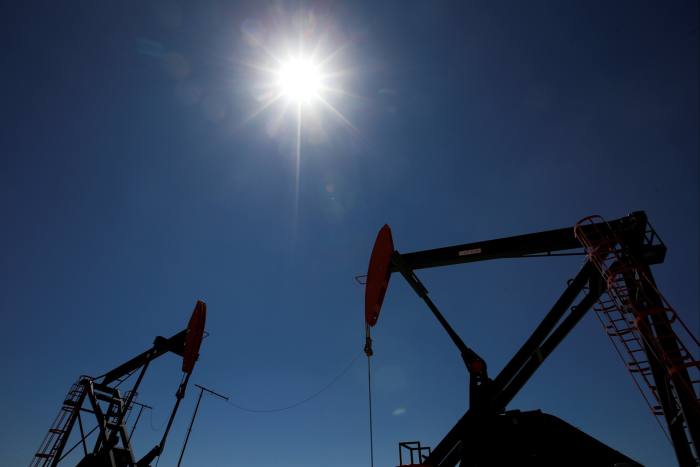Argentina hits milestone on path to gas export bonanza
Natural gas from the world’s second-largest shale gas reserve in Patagonia will reach Buenos Aires in the coming weeks through a new pipeline, marking a milestone in Argentina’s push to become a big gas exporter despite its economic turmoil.
The 573km pipeline will relieve a bottleneck at Vaca Muerta, a shale deposit larger than Belgium that was discovered in 2010 in the province of Neuquén. While gas production finally kicked off in 2018, a lack of transport infrastructure had left the fuel partially stranded.
Energy secretary Flavia Royón said the pipeline, named after the late former president Néstor Kirchner, is the first step in a plan to sharply increase gas production and exports, first to the region and later globally. It aims to complement modest but growing oil sales and turn Argentina back into a net exporter of energy, which it has not been for 13 years.
“From last year to 2030, we’ll go from a negative energy [trade] balance of $4.6bn to a positive one of approximately $18bn,” Royón said, noting that this would make energy Argentina’s second-biggest export after agricultural products and a source of much-needed dollars.
“This pipeline is an inflection point for Argentina’s energy development, and part of the solution to the difficult economic problems facing the country,” Royón said.

While significant investment hurdles remain, natural gas provides a badly needed point of optimism for Argentina, where the worst economic crisis in two decades has pushed annual inflation to 115.6 per cent and wiped out foreign exchange reserves.
Ahead of October’s presidential election, both the populist ruling Peronist coalition and pro-business opposition are hyping the potential of gas exports. They also have high hopes for a projected 2024 recovery of agricultural exports after last year’s drought and a sharp rise in lithium production by 2025.
Economy minister and Peronist presidential candidate Sergio Massa, who oversaw the long-delayed construction in just 10 months — although it was carried out by private companies — used its July 9 inauguration as a quasi-campaign launch.
“The one thing that all Argentina’s political camps agree on is that these sources of foreign currency offer the long-term solution to our problems,” said Juan Cruz Díaz, managing director of Cefeidas, a Buenos Aires-based political advisory group. “If they can sort out the macroeconomic situation first.”

The reserve contains 8.7tn cubic meters of gas and 16.2bn barrels of oil. Production is led by state energy company YPF along with Argentina’s Tecpetrol and local Total subsidiary Total Austral. Argentina exports some gas to Chile, but its ambitions are far greater.
The country also aims to scale up global and regional sales of more easily transportable oil from the Vaca Muerta formation. In May, consultancy Rystad Energy projected that by 2030 the field’s oil production could top 1mn barrels per day, more than triple current levels, if investment is maintained.
In the short term, the cash-strapped government says the new state-financed pipeline, which cost about $2.5bn, industry analysts estimate, will save Argentina $1.7bn this year and $4bn in 2024. Those savings will result from the country ceasing to buy LNG and Bolivian gas.
But much work remains to get Vaca Muerta’s gas moving around South America and beyond. The government will soon tender a series of pipeline projects designed to unlock the market of Argentina’s giant neighbour Brazil and increase capacity for exports to Chile and Uruguay.
One aim is to extend the Néstor Kirchner pipeline to San Jerónimo, about 250 miles from the Brazilian border, by next year. Brazil’s national development bank will fund a third of the $1.9bn price tag, and Royón said in May that Chinese group Power China is also interested in offering financing.
Another objective, also pegged for 2024, will reverse the flow of a pipeline in northern Argentina built to bring in gas from Bolivia, whose gas industry is in decline, at a cost of $800mn. Some $540mn has been committed by Latin American development bank CAF.

Daniel Gerold, director of Argentina’s G&G Energy Consultants, said the government’s timeline was “ambitious”, but he was optimistic that the…
Read More: Argentina hits milestone on path to gas export bonanza

